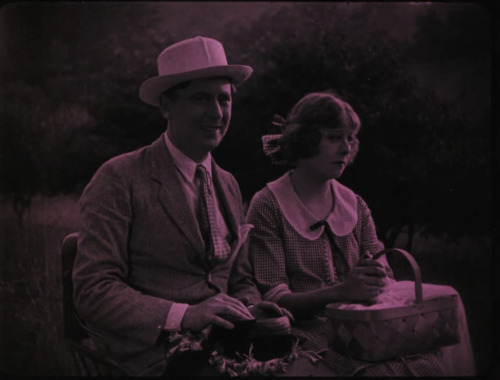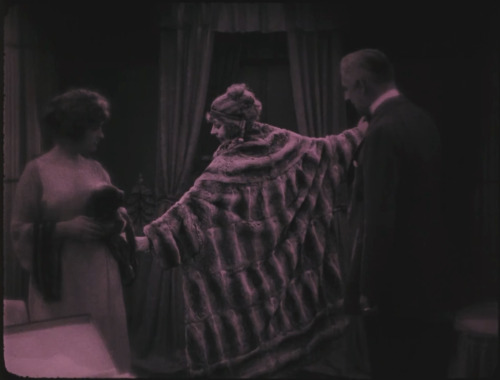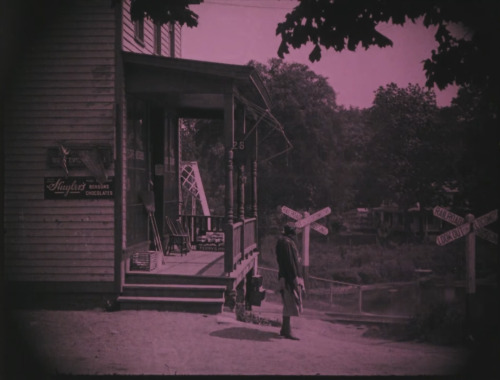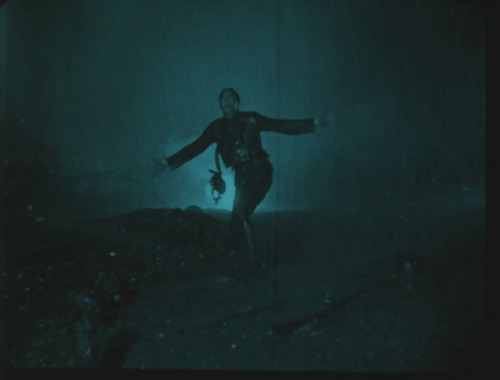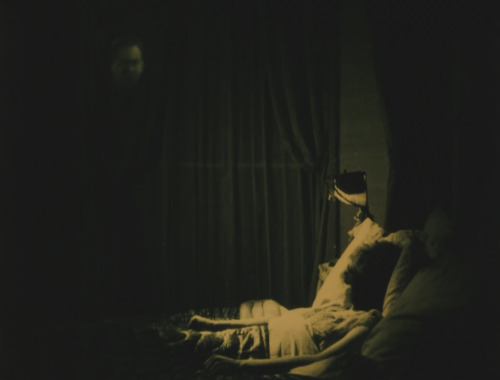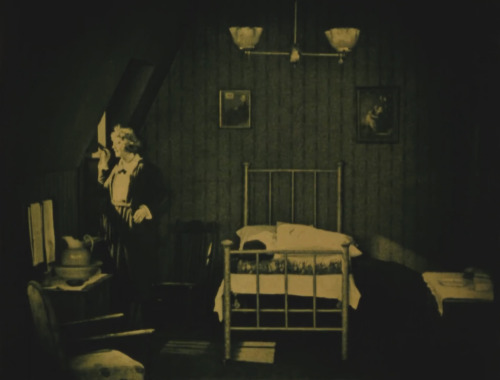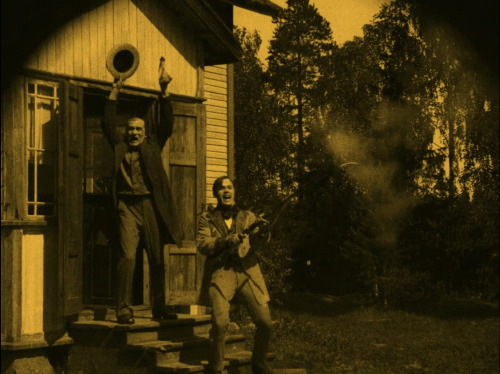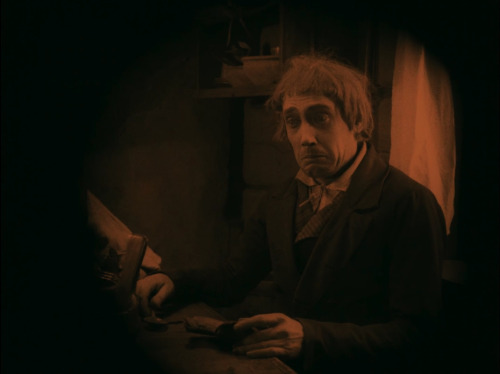#silents

For some reason, I thought it would be a good idea to watch somewhere around 50 Christmas and Christmas-adjacent silent films from before 1920 to put together a playlist for you all. So, I hope you enjoy!
I chose these twelve as a representative selection. My general criteria were:
- Christmas should be central to the story
- The plot should be novel to a modern viewer or something a modern viewer would be surprised to see so early on film
- The list on the whole should have a variety of settings and narrative structures
Here’s a direct link to the YouTube playlist if you want to watch them all in one go. (They are all shorter than feature length!)
Two quick presentation notes: 1. Some of the videos have music and some don’t, so you may want to check your volume level. 2. The intertitles for some of these films are not in English, so be sure you have captions turned on for English translations.
See the whole list BELOW THE JUMP!
1.Santa Claus (1898) (UK)
Directed by George Albert Smith
Short and sweet, this film sees children put to bed by their nanny on Christmas Eve and Santa Claus coming down the chimbley to fill their dutifully hung stockings. Director G.A. Smith used his own patented technique of double exposure to show Santa’s arrival without cutting away from the children’s room. Santa Claus might not pack the punch of a Méliès trick film, but it’s a fun novelty and is purportedly the first appearance of Santa Claus on film.
2.The Little Match Seller (1902) (UK)
Directed by James Williamson
This one’s quick but effective adaptation of the Hans Christian Anderson tragedy featuring impressively well-coordinated superimpositions.
3.The Christmas Angel (1904) (FR)
Directed by George Méliès for Star Film Company
The Christmas Angel follows an impoverished girl driven into the city to beg on a snowy winter night. First she’s chased away from a church by more seasoned beggars; then she’s thrown out of a poultry seller and harassed by police. On the verge of falling asleep in the snow, a rag-and-bone man rouses her and offers her help. Later, the girl passes out beside a road but is luckily spotted by a wealthy couple on a car ride. When they learn of her plight, they bring her home along with food and gifts.
Though not as fantastical as some of Méliès’ more famous works, The Christmas Angel is still highly stylized (and stylish) and features special effects that photograph beautifully. It’s also worth noting that the version of the film included here is the American cut. The original French cut, titled Détresse et Charité (Distress and Charity), did not include the sequence with the wealthy couple and instead ends with the girl dying in the snow.
4.The Night Before Christmas (1905) (US)
Directed by Edwin S. Porter for Edison Manufacturing Company
This is the first time the poem “Twas the Night Before Christmas” was put on film. Loosely following the poem, we see Santa Claus prepare for his yearly trek while a middle-class family prepares for his visit. When Santa heads out, we are treated to an extended panning sequence with a fully painted backdrop for a mini Santa and his reindeer to glide across. When Santa arrives at the family home, he chaotically dumps presents and decorations around their living room and makes a large, decorated tree appear out of thin air. (Across many of the movies I watched to put this post together, this seems to be a favored scenario for the jolly fat man around this time–and it’s delightful.) The family then wakes to find their gifts and the film closes with Santa directly wishing us a Merry Christmas.
5.A Little Girl Who Did Not Believe in Santa Claus (1907) (US)
Directed by J. Searle Dawley and Edwin S. Porter for Edison Manufacturing Company
Even at the risk of this list being too Edison heavy, I couldn’t leave this great short out. While walking with his mother, a rich little boy encounters a poor little girl alone in the cold. They take her home to play and warm up. When the boy learns that the girl doesn’t believe in Santa because apparently Santa doesn’t visit poor children, he hatches a scheme. On Christmas Eve, the boy has a stake out near the fireplace and takes Santa hostage, tying him up and holding him at gunpoint. The boy then forces Santa to visit the girl–going so far as shimmying down the chimney himself to let Santa in the front door. When the girl wakes up to a beautifully decorated tree, new toys, and a full stocking, she can finally believe in Santa Claus. While I’m generally not so into stories about supposedly benevolent rich people, I do love the implications this story has on how Santa Claus works and I also find the means with which the boy gets his way hilarious.
6.Il Natale di Cretinetti / Foolshead’s Christmas (1909) (IT)
andCome fu che l’ingordigia rovino il Natale di Cretinetti / How Greediness Spoilt Foolshead’s Christmas(1910)
andIl Natale di Cretinetti(1911)
Directed by Andre Deed for Itala Film
This entry is a three-for, which I hope you’ll excuse, but I couldn’t decide which Cretinetti Christmas to share! Cretinetti, the comedic persona of filmmaker Andre Deed, is an absolute agent of chaos.
In the 1909 film, Cretinetti attempts to bring a tree home for a Christmas party. The destruction escalates wildly, culminating in an entire building falling to pieces.
If you can believe it, the stakes are even higher in the 1910 film, when Cretinetti can’t resist sneaking out of bed on Christmas Eve to snack on the candy decorating the tree. When Santa sees what Cretinetti has done, he chides him and takes him back to his workshop, which is apparently in heaven. Destruction ensues. Cretinetti then proceeds to cause havoc for Saint Peter, annoying god so much that he calls the devil to come get Cretinetti. Cretinetti is then chased to hell where demons try to cook him alive. Thankfully, spoiler alert, it was all a bad dream and he wakes up on Christmas morning with a terrible stomach ache.
The 1911 film returns to localized chaos. Cretinetti has a run-in with a mail carrier and his Christmas packages get mixed up with one of the carrier’s parcels. The parcel contains three bottles of ether which then begin to emit gasses in the middle of the family Christmas party.
I wasn’t familiar with Cretinetti before reviewing films for this list, but I’m definitely going to seek out more of Deed’s movies. Each of these films had well-executed chaotic slapstick; over-the-top in all the right ways.
7.Making Christmas Crackers (1910) (UK)
Produced by Cricks & Martin Films for Clarke, Nickolls, & Coombs Confectionery
To start, if you’re not sure what a Christmas cracker is, it’s a colorfully decorated paper tube that makes a cracking noise as you pull it open. Inside the tube is a paper hat, a joke, and/or a small toy. It’s a traditional part of UK Christmas celebrations.
This short starts as a documentary of the workers at Clarke, Nickolls, & Coombs constructing the crackers. It’s a fun thought that as early as 1910, people were interested in watching how mass-produced consumer goods were made. It’s also fun to see these skilled workers ply their trade so deftly (even though I’m sure wages and working conditions were less than ideal). The film ends with a family celebrating around a Christmas tree topped with a functional giant cracker.
8.A Christmas Carol (1910) (US)
Directed by J. Searle Dawley for Edison Films Manufacturing Company
There are so so so many film adaptations of Charles Dickens’ A Christmas Carol made before 1920 that it was hard to choose which one to include on this list. In the end I chose this 1910 version for its economy of storytelling, fluid use of special effects, and for Marc McDermott’s great performance as Scrooge.
9.Broncho Billy’s Christmas Dinner (1911) (US)
Directed by Gilbert M. Anderson (Broncho Billy) for The Essanay Film Manufacturing Company
Gilbert M. Anderson was an incredibly prolific and popular filmmaker and star of early American film, particularly in his role as Broncho Billy. As was typical for Anderson, he’s pulling triple duty on Broncho Billy’s Christmas Dinner as the star, director, and producer. The film features a simple and heartwarming story.
On Christmas, Billy comes across a young woman in peril as her horses got startled and are now pulling her cart along wildly. Billy manages to wrangle the horses and in gratitude she invites him to Christmas dinner at her parents’ home. Unfortunately, her father happens to be the sheriff. But, all is well, as it turns out that Broncho Billy’s been given a pardon and the sheriff welcomes him to the table gladly.
The enduring appeal of outlaws or criminals getting into the Christmas spirit is fascinating to me and it’s cool to see such an early instance of the story!
10.Le Noel de la princesse / The Little Princess’s XMas Gift (1911) (FR)
Produced by Société Générale des Cinématographes Éclipse
In all honesty, this is the least Christmassy of all the films I included here, but its style and novelty stood out. The sets, costuming, and production design are lush. It might also be one of the weirdest Christmas stories I’ve even encountered.
After Lord Othberg passes away, the conniving Otto plans to assassinate the baby prince in order to inherit the lordship himself. He poisons the baby, but the princess prays for her baby brother to come back to life as her Christmas gift. An angel appears to her and they summon Jesus, who resurrects her baby brother. Of course, they then place the revivified baby in the castle’s nativity scene, to the joy of all but Otto.
11.Ida’s Christmas (1912) (US)
Directed by Van Dyke Brooke for Vitagraph Company of America
With a more classic Christmassy story, Ida’s Christmas tells us of a family who are facing hard times. Ida (played by a very small Dolores Costello) has her eyes on a pricey doll. Meanwhile, her mother seeks out employment with a wealthy family. The matriarch of the wealthy family overhears Ida’s wish and decides to buy the doll for her as a surprise. Later, Ida is distraught to find that the doll has been purchased but comes across a wallet that someone has dropped. She considers taking the money, but chases down the owner instead. The old man gives her some reward money for returning the wallet. Ida rushes to see if she can buy the doll, but has second thoughts when she thinks about how much her family could use the money. She arrives home with the money just in time for a Santa-esque old man to show up bearing packages and an assurance that the wealthy family has work for her father. The film ends with the family celebrating an unexpectedly Merry Christmas.
It’s a sweet story that hits so many beats of what we now consider traditional Christmas tales.
12.Rozhdestvo obitateley lesa / The Insect’s Christmas (1913) (RU)
Directed by Władysław Starewicz for Khanzhonkov
Fair warning, if you thought The Princess’s XMas Gift was odd, you might need to ready yourself for this one. Stop-motion virtuoso Władysław Starewicz (Ladislas Starevich) spins a tale about a tiny ornament of Santa/Ded Moroz coming to life on Christmas and going out into the wild to bring Christmas joy to creatures small and smaller, including a frog and a ladybug. Starewicz’s animation is as impeccable as ever and the short is imaginative and quirky.

The Star
Born into show business, Dolores Costello’s parents, Maurice and Mae, were both performers on stage and in early films for Vitagraph. Dolores had multiple credits in Vitagraph films before she even celebrated her tenth birthday. In fact, I’ve already covered one of Dolores’ early films on this blog, as part of my Christmas movie throwback list.
As Dolores and her sister Helene aged out of child roles, they hopped over to New York and worked as models and on stage for Florenz Ziegfeld. Famed Broadway producer Ziegfeld ran a series of very successful revues on Broadway featuring showgirls who exemplified a specific brand of free-wheeling, vigorous femininity. Such was their popularity that the nickname “Ziegfeld girl” had nationwide recognition. Many Ziegfeld girls found success on film – Dolores and Helene were brought back to the movie business by Warner Brothers. After some minor roles, Dolores was picked by John Barrymore to star alongside him in The Sea Beast (1926), which was loosely inspired by the novel Moby-Dick. Dolores’ star rose dramatically over the next few years and she would marry Barrymore in 1928.

The Cosplay
When I originally saw these portraits of Costello, I immediately wanted to recreate them in closet cosplay. But, even now, I haven’t been able to definitively pinpoint when they were taken or if they were taken to promote a specific film. Based on her styling, I reckon they were likely shot around 1928-29. Then I came across an uncited suggestion that they were taken during the production of Noah’s Ark (1928). So, I watched it and the assumption seems probable. I did not intend to make this a post about a movie, but Noah’s Ark is so interesting, I couldn’t help myself!

The Film
Noah’s Ark is fascinating. It stands firmly between the silent and sound eras. Darryl F. Zanuck conceived the film as a dual story: a World War I romance tale and a creative retelling of the story of Noah from the book of Genesis. Originally planned as a fully-silent epic, the production of Noah’s Ark was extended due to the emergence of talkies. Sound segments were filmed making Noah’s Ark one of many hybrid films made in this transitional period. Though it was released at the end of Hollywood’s sound/silent hybrid cycle, it was a big box office success.

The film begins with a preface likening biblical stories to contemporary life, easing the viewer into the mirrored story of the flood/WWI. The story commences with our cast of characters on a train traveling through Europe, carrying a very international crowd. We meet two all-American types, Travis (George O’Brien) and Al (Guinn “Big Boy” Williams), a German showgirl, Marie (Costello), a minister (Paul McAllister), and a Russian intelligence agent, Nickoloff (Noah Beery). The train is violently derailed over a bridge, but Travis and Al manage to save Marie and end up at a local inn with other survivors, including Nikoloff. Travis saves Marie once more that night, as Nickoloff sneaks into her room with ill intent. At the same time, soldiers arrive at the inn announcing that war has broken out.
Later, in Paris, Marie and Travis have fallen in love and marry, while Al enlists in the army. Travis finds it hard to say goodbye to his good friend and gets swept up when he sees Al marching away. Travis quickly joins up too, leaving Marie to fend for herself–a German citizen stuck in France in the middle of the war(!!!). All three lose touch. In a heart-wrenching turn of events, when Al and Travis by chance end up in the same trench together, the chaos of the battlefield leads Travis to accidentally kill Al with a grenade. Back in the city, Marie has resumed working as a showgirl where she is recognized by Nickoloff, who has her arrested as a German spy. Nickoloff plants evidence on her and uses his influence to ensure that she gets the firing squad. In another chance encounter, one of the military men assigned to carry out the execution is Travis, who immediately attempts to stop the execution. At that moment, however, a German attack buries the whole lot of them under a ton of rubble. As they sit without much hope of survival, the minister (the same one from the train), recounts the story of the flood.
Noah (McAllister) lives in a kingdom ruled by King Nephilim (Beery) who worships a god called Jaghuth. God warns Noah of the oncoming flood and Noah has his sons begin constructing a massive ark. One of Noah’s sons, Japheth (O’Brien), is in love with their servant girl, Miriam (Costello). King Nephilim plans to sacrifice Miriam and kidnaps her. When Japheth tries to save Miriam, he is captured, blinded, and forced into hard labor. The flood comes suddenly just as Miriam is about to be killed. Japheth manages to escape his chains and his sight is restored divinely. He finds Miriam and the two make their way to the ark. Meanwhile, a whole menagerie of animals also make their way to the ark while masses of people are battered by waves and washed away.
Returning to the 1910s, the people buried under the rubble are rescued and learn that the armistice is signed and the war is over.
READ MORE below the jump!
The production of this film was a massive undertaking. All of the special effects are dazzling. The compositing, miniature work, and matte paintings all really stood out to me. Now, the flood sequences were a lot to take in. It’s been reported that some stunt performers were killed filming these scenes and many were badly injured. I managed to track down five different books that report this, all with slightly different accounts. However, none of them cite a source for this information, so I’m not sure how much of it is apocryphal. Regardless, it’s easy to believe. Many of the shots of the flood waters bombarding these extras are wide shots with lots of people and lots of water. Trying to film those shots while adequately monitoring the safety of all performers seems likely impossible. (One reason we should be very grateful for CG nowadays IMO.)
I’d honestly recommend this movie broadly because its excess alone is remarkable and the dual-story format is entertainingly strange. However, watching this on the other side of the Second World War makes the hopeful ending totally gut wrenching.
Also, the relationship between Al and Travis is so so so queer. O’Brien and Williams have a lot more chemistry together than O’Brien and Costello. But, honestly, that chemistry imbalance actually makes the 1910s section more interesting.
Despite the film’s extended production, it made a very tidy profit. While Costello’s films during the silent/sound transition were popular, she had a minor speech impediment that made the process bumpy for her. And so, a few years later, Costello chose to retire to focus on raising her children. After divorcing Barrymore, Costello made a strong, but unfortunately short comeback to films. Thankfully, before her re-retirement in the 1940s, we all got her wonderful turn in The Magnificent Ambersons(1942).

Dolores Costello, for me, represents a kind of sehnsucht. The fits and starts of her career gave us captivating glimpses at what could have been a full and ranging filmography, but never came to fruition. Noah’s Ark is one of those glimpses. The gravity of Marie’s situation settling on to her is so effectively communicated through Costello’s face and body language–all of the uncertainty, anxiety, abandonment–that little needs to be made explicit in the 1910s section. What a gift she had!

1922 in 2022: Back Pay(1922)
Directed by Frank Borzage
Adapted for the screen by Frances Marion
Based on a story by Fannie Hurst
Photographed by Chester Lyons
Produced by Cosmopolitan Productions
Premiered on 8 January 1922
Synopsis:
Hester Bevins (Seena Owen) dreams of a bigger, more extravagant life than her small-town home of Demopolis can offer. When Hester decries her flannel and gingham lifestyle to her beau, Jerry (Matt Moore), he doesn’t take her seriously. Regardless, once Hester has the scratch, she moves to New York City. There, she toils in obscurity for a few years before she lands a tycoon boyfriend, Wheeler (J. Barney Sherry). Though Hester has settled into the lap of luxury, she hasn’t forgotten her roots. Hester returns to Demopolis for a spell while on a road trip with Wheeler and friends. There she finds the whole town has forgotten her, except for Jerry. Jerry still insists Hester belongs in gingham and with a heavy heart she rejects him again and returns to the city. Normal life resumes for Hester, while Jerry enlists to fight in World War I. After Hester discovers that Jerry has returned to the States wounded, she rushes to the hospital and is informed that he only has three weeks to live. Hester thinks up a scheme to make the most of his last days by marrying him and convincing the now-blind Jerry that she’s living in a humble one-room apartment on earnest wages. She easily gains Wheeler’s agreement to support this arrangement. The pair live out an imitation of Jerry’s modest domestic fantasy until Jerry’s death. Hester unexpectedly finds that she is unable to return to her former life. Hester is haunted by the spectre of Jerry and feels guilty for her ruse. After her maid foils an attempted suicide, Hester resolves to become the person Jerry believed she was. Hester moves into a dingy one-room apartment, reclaims her old job, and is determined to pay for Jerry’s funeral with money she earned “honestly” as a final act of atonement.
My Impressions:
There was a lot I liked about this movie, and I really enjoyed Seena Owen’s performance, but the morality of the story was so shallow that it left me frustrated.
There’s not much information online about the movie, so I tried to scan through movie magazines from the time with little luck. Then I ended up finding a contemporary review cited on Back Pay’s Wikipedia page! The reviewer, James W. Dean, was also disenchanted with the hollowness of the film. Dean was already familiar with the story from the original publication (in Cosmopolitan Magazine in 1921) and from the stage play which was running while Back Pay was produced and released. And, according to Dean, the movie adaptation gutted the substance of the story. This spurred me on to find a copy of the original story and golly was Dean right!
In the story, Hester’s childhood in Demopolis is recounted in a way that deeply informs the choices she makes as an adult. Hester was raised by a protective aunt who also happened to be running an adult establishment out of her home. These childhood experiences shape Hester’s view of men and her expectations of life. This also frames Demopolis as less of a sleepy, idyllic bit of Americana. The film contains no hint of Hester’s life before the plot commences.
The film also whittles down the character of Wheeler, who in the story has a wife and child he’s double timing. He’s also searingly referred to as a “parlor patriot.” As the war rages abroad, Wheeler is specifically described as a war profiteer. When Hester asks him to do a solid for a disabled veteran, she even mentions that it’s only right seeing how much money he’s made off the war!
There isn’t much different about Jerry between the two versions of the story, aside from some blatant anti-Semitism is the original story. Honestly, even with the bigotry removed, I found it hard to like a character whose main trait is invalidating his girlfriend’s self image.
While the original story also tackles morality and guilt, the added depth of Hester’s psychology and the added shittiness of Wheeler make for a much more dynamic story.
So, I’ve ragged a lot on what was removed from “Back Pay” when it was adapted for the screen, but there is one addition that stuck with me. It regards Hester’s live-in maid. The maid isn’t a full character in either version of the story. But, if you remember from the synopsis, after the maid saves Hester’s life, Hester decides to up and leave. In other words, Hester abandons this very loyal woman in the early hours of the morning, leaving her potentially homeless and jobless with absolutely no prior notice. But, seemingly Borzage had some awareness of how completely insensitive this act was, because the camera lingers on the (unfortunately uncredited) maid looking anxious and despondent after Hester’s departure. This minimal moment is more thought given to that character than the original story, shockingly.
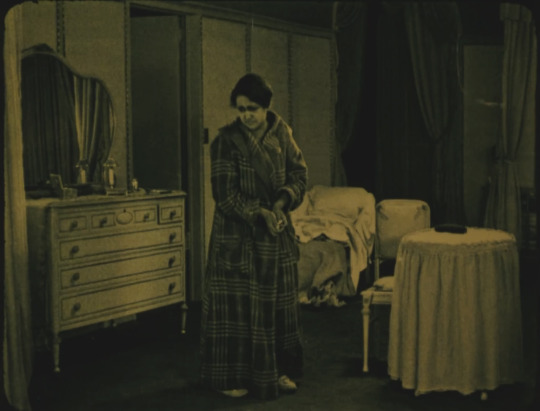
The aforementioned shot of the tragically uncredited maid.
Further Info: [below the jump!]
- Adjusted for inflation, the chinchilla coat that Hester wants Wheeler to buy for her would be $368,170.00 in 2022 dollars. Jerry’s funeral costs would be $8,848.63. (Although the movie is set some time in the 1910s, not 1922 so the numbers would be slightly different in actuality.)
- Back Pay was produced by Cosmopolitan Productions, which was owned by newspaper magnate William Randolph Hearst. The business model of Cosmopolitan was that it would have the film rights to the popular stories that ran in Hearst’s magazines and would also be able to promote the films in Hearst-owned publications. At the time Back Pay was made, Cosmopolitan’s films were distributed through Paramount.
- Back Pay was shot at Cosmopolitan’s New York studio located at Harlem River Park. The area used to contain an amusement park and casino. However, a year after Back Pay was released, while production ofLittle Old New York(1923) with Marion Davies was under way, the studio burned down. This precipitated the studio moving production to California.

Photo of Cosmopolitan’s studio c. 1923 from the HABG Task Force website.
The city block where the studio once stood (between 1st & 2nd and E 126th & E 127th in Harlem) was, until recently, a city bus depot abutting a bridge ramp. We often talk about how much has changed in Hollywood in the last century, but the old movie-making enclaves in New York and New Jersey have also changed massively! I bet the view across the river from the studio was lovely back then!

The block as seen on Google Maps in 2019. (Shoutout to this dude in a Dragon Ball Z t-shirt btw)
Seeing as this post is already a beast, I’ll quickly say that the history of this location, going all the way back to when Harlem was still Nieuw Harlem is fascinating and the redevelopment plans for the area sound great! The website Urban Archive has a full survey. It’s worth a read!
You can also check out the HABG Task Force website for details on the redevelopment, which is currently slated to be completed in 2023.
Post link
Kihlaus / The Betrothal(1922)
Directed and adapted for the screen by Teuvo Puro
Based on a play by Aleksis Kivi
Photographed by Kurt Jäger
Produced by Suomi-Film
Synopsis:
A tailor called Aapeli (Martti Tuukka) receives a letter from a childhood sweetheart, Eeva (Annie Mörk), in which she agrees to marry him. Aapeli dashes off to pick up his bride-to-be, while his colleague, Eenokki (Iisakki Lattu), and his apprentice, Jooseppi (Uuno Kantanen), sympathize over what they fear is a bad match. Things don’t start off well for the couple, as the raucous “gentlemen” whom Eeva lives with decide to send her off with one last prank: placing an ember under the tail of Aapeli’s horse, Rusko. This causes Rusko to bolt with the panicking new couple in tow. When they arrive at Aapeli’s house, with nerves raw, Eeva quickly regrets her betrothal agreement and, equally as quickly, makes Aapeli regret his end of the agreement as well. In the end, Eeva returns home to her gentlemen on foot and fuming, while Aapeli is left with his friends making their best effort to cheer him.
Quick impressions:
- The toning throughout the film is incredibly rich and adds a liveliness to the pastoral settings depicted.
- It’s not exactly a laugh riot, but the mugging is top-notch.
- I find it fun whenever I come across a movie that presumes familiarity with its source material and that source material is wholly unknown to me. If you want to check this movie out though, reading this post is probably familiarity enough!
About the film:
Director Puro was a pioneer of the Finnish cinema. He was co-director of Finland’s first narrative film, The Moonshiners (1907). Puro went on to form the first film production company in Finland to focus solely on features. The company struggled with funding and Puro’s career faltered until the 1920s, when he began working for Suomi-Film.
Kihlaus(1922) was the second film adaptation of the play by renowned 19th-century Finnish writer Aleksis Kivi. The first was produced in 1920.
Kihlausdebuted on 9 January 1922 in Helsinki, Finland at the Kino-Palatsi. The Kino-Palatsi (Cinema Palace) was an art-nouveau theatre built in 1911, adjacent to Suomi-Film’s head office in Helsinki. Unfortunately, the theatre was demolished in 1965. In its place at the intersection of Keskuskatu & Pohjoisesplanadi, a bookstore was built, which still stands there today.
Sadly I wasn’t able to find any photos of the theatre contemporary to Kihlaus’ release, but here are a few taken before its demolition:


“Interior of Kino-Palatsi cinema in Helsinki in 1964” by Helsinki City Museum underCreative Commons Attribution-Share Alike 4.0 International license.
And the spot today:

Post link








